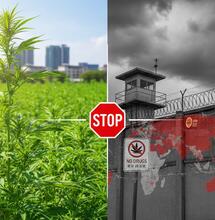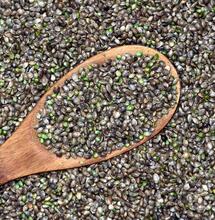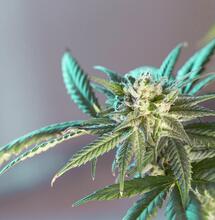Better Buds with Mr. Bill: Your Lights Directly Control Your Yield, Part I

Our expert Cannabis grower, Mr. Bill, shares some essential information about light positioning, distribution of light and yield.
Our expert Cannabis grower, Mr. Bill, shares some essential information about light positioning, distribution of light and yield.
Mr. Bill is ready to assist you by drawing upon over twenty-eight years of active grow shop experience - including answering growers' questions about the hydroponic industry. Before Mr. Bill opened his first store he worked in the agricultural industry for five years, growing tobacco.
|
Light is necessary for photosynthesis, which keeps plants healthy and green |
We all depend upon the process of photosynthesis; this allows our bodies to gain strength by capturing light energy from the sun, and also from mineral elements. Earth, with about three billion years of photosynthesis processing, has produced an atmosphere rich in oxygen that now supports the evolution of all complex forms of life.
Our planet is constantly being bombarded with radiant energy from our sun, equivalent to about one million Hiroshima-sized atomic bombs each day. About a third of this energy is reflected back into space; most of the energy is absorbed by the planet, about one percent of which is converted into photosynthesis. This energy is what drives most of the life on this planet.
What is light?
We cannot see light or feel light, although we can feel the heat given off by the excitement of atoms. Different parts of the electromagnetic spectrum, namely in the 380- to 750-NM range, will excite electrons in the atoms, causing the electrons to have higher energy levels. This higher energy level does not cause the atom to move, but does give it more energy. This energy is passed from one atom to another and the first atom then goes back to its regular energy level.
Light is energy and all plants, algae and most types of bacteria can use light energy through green chlorophyll. Chlorophyll absorbs photons of a narrow energy level and each pigment is acceptable to only a very narrow range of wavelengths - chlorophyll A and B, for example, are very good at absorbing red and blue light. A chemical reaction during plant growth involves the electron that was removed from the chlorophyll at the start of the reaction. This electron must be returned to the pigment or another source of electrons must be replenished; otherwise, a chemical failure would occur, causing the plant to turn white. Then, no photosynthesis could take place.
Light energy and different mineral elements will cause different reactions in taste. As you can see, light is very important to plants, algae and bacteria; these entities are the only living things that can take mineral elements from the earth and give mammals and marine creatures these same mineral elements in a form that we may consume for life energy. If we are using artificial light, we must not waste it, as it is costly. Proper placement of plants, color spectra, heat and humidity all play a major factor in over-all plant health.
|
The orientation of the burning position of your lamp can cause loss of light |
Getting the Most Out of Your Lights
Simply hanging your lights in your grow room is not the best way of illuminating your garden - there are certain criteria that should be followed.
So, how much light is enough for a certain area? If your plants are going to be less than thirty inches tall, calculate by taking the length and width and multiply them together to get your total square footage: a room that is five-by-five feet would be a total of twenty-five square feet. Next, divide the square feet into the wattage of your lamp: 1000 watts divided by twenty-five square feet equals forty watts per square foot. Anything over thirty-five watts per square foot is acceptable light for plants that are less than thirty inches tall.
At any level of light over sixty-five watts per square foot, it would be wiser to add more growing area and adding a light to a new growing area, rather than adding another light to an existing growing area. This would not only double the growing area but would also double the yield. I believe that anything over sixty-five watts of light per square foot is wasting light and you would be better off adding more plants and growing area to accommodate the new growth.
If you are planning to grow plants taller than thirty inches and want great production from the top to the lower branches, you may have to add another 1000-watt lamp. Add the additional lamp between your plants, with no reflector - this allows the light to penetrate, reaching more foliage, but be careful not to burn your leaves. Keep the original light above your garden in a manner that also does not burn your growing tips.
|
When using horizontal lighting, try to maintain as even distribution as possible above the plant canopy |
Is your growing space larger than the five-by-five area above? If so, then will you need to add more lights? You will want to keep the light as even as possible over the canopy of your plants. Look at this figure about using horizontal reflectors. Notice how the reflector has an inverted 'V'; this directs the light away from the arc tube of the light source. You will need to find out what your reflector light pattern is.
To find out what your light pattern is, turn off all other lights and create fog or dust to allow the beams of light to show, or use a Lux light meter. With one lamp and horizontal reflector, the light will have an inverted 'V' effect that comes up from the floor to the light source - make sure that the growing tips of your plants do not enter this non-lighted area, as it will provide very little light. As your plants grow closer to the reflector, the inverted V has less area that the light can illuminate.
|
Check the 'footprint' of your lamps to aid in correct plant placement |
Suppose that the 'footprint' of your light on the floor is three-by-four feet, at twelve inches away from the reflector. You may only have twelve-by-sixteen inches of coverage at the light source without burning your plants. This is a problem, especially if you had plants growing straight up from the three-by-four area; very soon, plants will have grown out of the cone of light. To correct this, you would need to add more lights to the growing area of the same or lower wattage.
Imagine that you are growing in a five-by-ten-foot area. Since one light will not illuminate that entire area, you would need to add more than one lamp. If you raised the light by about a foot (less light as you raise the lamp) the cone should now cover the five-foot width, but sixteen inches above the growing container, the cone of light will have faded out. You can raise the lights, keeping the cone of light on the plants.
However, you still needed to illuminate all the area of the five-by-ten-foot area and now need to add another light or two. As your plants grow, the lights are raised above the plants; not all plants can be moved, due to height restrictions or if they were planted in certain growing media and containers that do not allow for rearranging plants placement. This can cause your plants to receive uneven delivery of light, causing more problems and still making it harder to illuminate your garden with horizontal lights. Lighting is much simpler and has a better spread when using a forty-two-inch vertical 'China hat'-style reflector.
When illuminating your garden with vertical reflectors, the beam of light goes straight out to the sides and is reflected downward because of the cone-shaped reflector, allowing for much taller plants. You will also achieve more even light penetration throughout the garden.
Suppose, again, that you are trying to illuminate the five-by-ten-foot garden. Since the light is directed all the way over to the side of the growing area, the growing tip of the plant will receive proper light to stimulate and support growth. When adding the second light, position the second reflector so that the light is twelve to eighteen inches away from the first reflector. Since all plants under the two reflectors receive basically all the light that they need from each, there will be more evenly-distributed light and less chances of having plants stretch towards the illumination.



